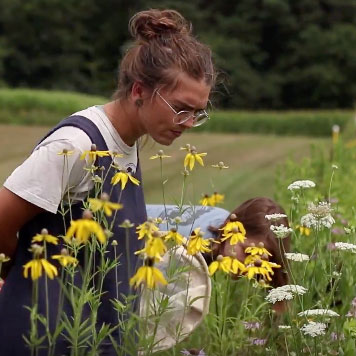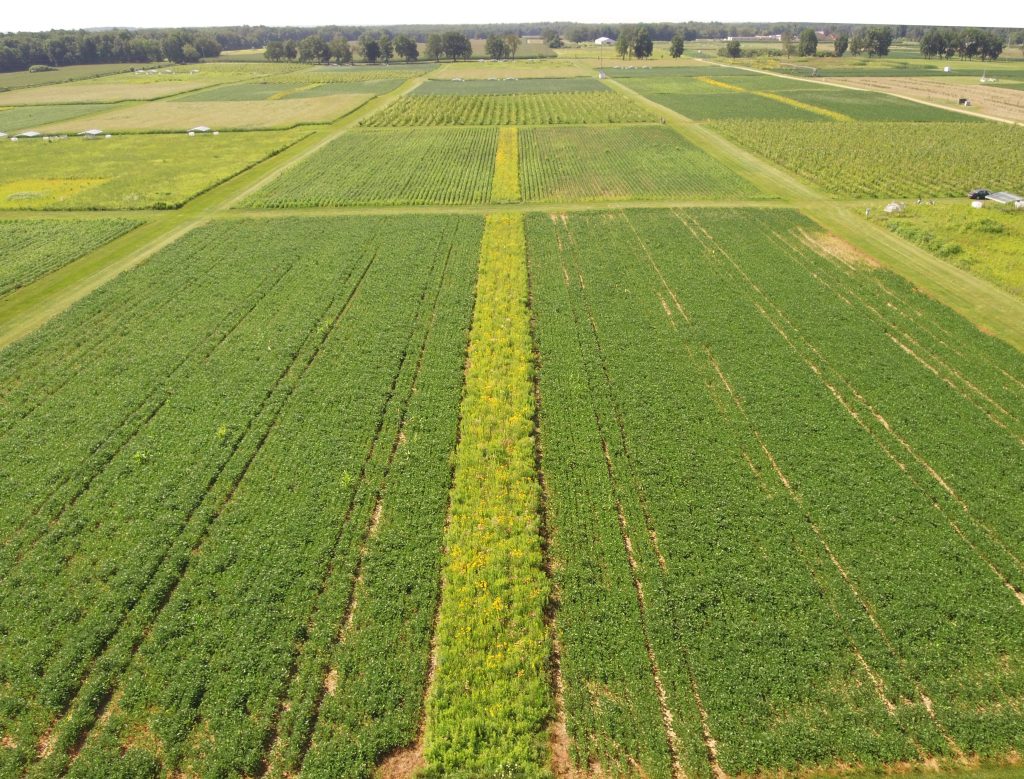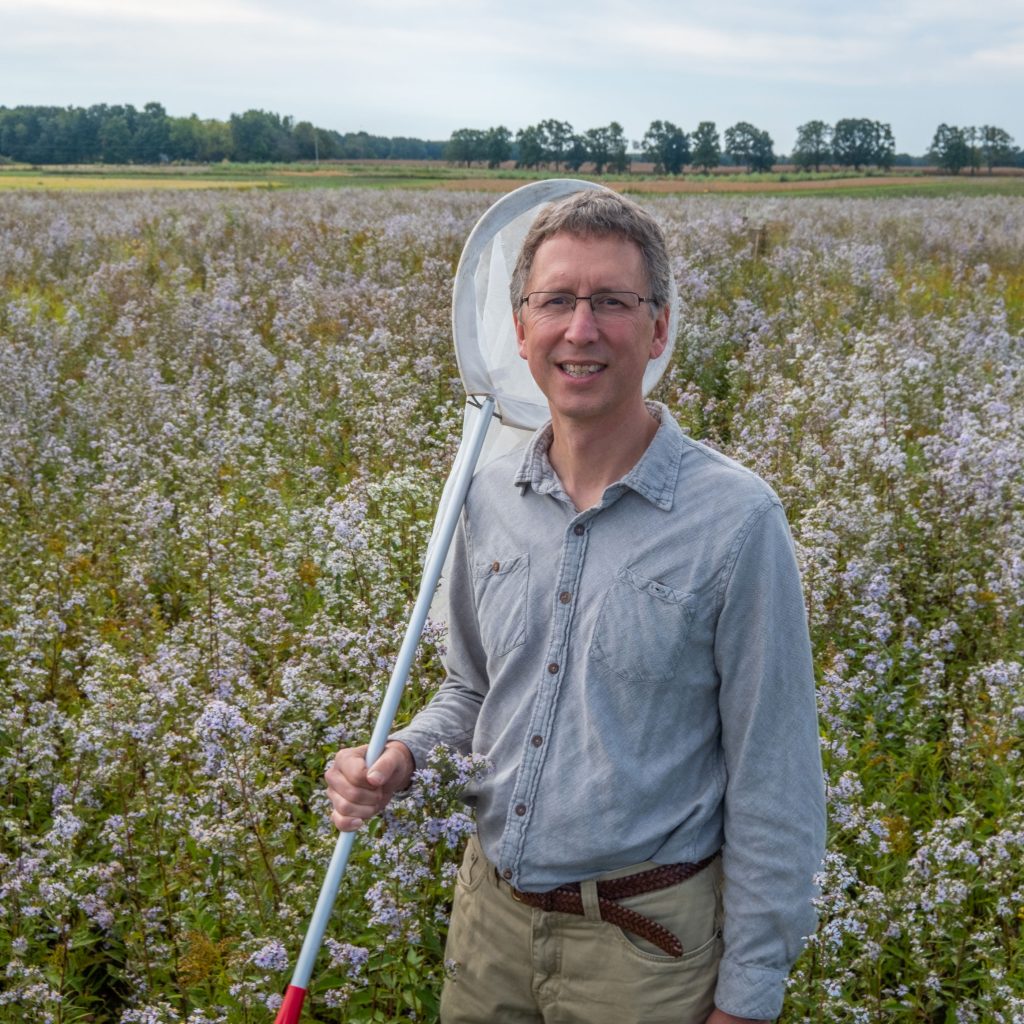One of our most urgent challenges is squaring the need to produce enough food for a global population with addressing the loss of biodiversity that results from converting land for agricultural use. But recent findings from W.K. Kellogg Biological Station researchers suggest those needs could be met in tandem—that bringing a little prairie back to farms in Michigan and other parts of the Midwest could help preserve both biodiversity and crop yields.
“The goal is to do both simultaneously in the vast area planted in row crops,” said Lindsey Kemmerling, the first author of the Michigan State University-led study published May 10 in the journal Frontiers in Ecology and Evolution. “We need to make this land habitable for species and for the ecosystem services the increased biodiversity can provide to the farms.”
Kemmerling earned her doctorate while working on the project in the lab of Nick Haddad, a professor at MSU’s W.K. Kellogg Biological Station in the College of Natural Science’s Department of Integrative Biology and in the Ecology, Evolution and Behavior program. Several other contributors to the study are KBS faculty, staff, students or alumni, including Haddad, Esbeiry Cordova-Ortiz, Sarah Evans, Jackson Helms IV, Corinn Rutkoski, and Jamie Smith.
Seeds of a study
The research team studied a variety of current farmland management practices with a twist. Working at KBS, they selected narrow regions in research fields where, instead of crops, they planted prairie vegetation native to southwest Michigan. These regions grew into what are known as prairie strips, slivers of land that increase biodiversity by attracting native pollinators and other organisms that are less prevalent on developed land.
They showed that a prairie strip’s flora and fauna brought an array of beneficial “ecosystem services” to the strips and the surrounding farmland. For example, the prairie strips attracted more pollinators and increased pollinator activity near the strips.
In addition to increasing pollinator abundance and activity, prairie strips also bolstered a plot’s natural pest defenses with a larger abundance of spiders, and they attracted more dung beetles, which can break apart manure and liberate nutrients for plants and soil. Also encouraging were the indications that prairie strips could enhance a plot’s carbon-storing capacity, thanks in part to the larger and deeper root system that prairie plants develop.
What’s more, when combined with the right field management practices, the array of benefits gained by adding a prairie strip essentially offset the loss of cropland. That is, prairie strips could be implemented without compromising crop yield.
“Prairie strips have broad-ranging effects — including improved soil health and increased biodiversity,” said Haddad, who is also the director of the Long-Term Ecological Research, or LTER, site at KBS. “We were excited to see that the benefits of prairie strips for biodiversity and ecosystems in the strips spilled over into cropland.”
Long-term studies for the future
Working with collaborators from Hawai’i Pacific University, the University of Puerto Rico and the U.S. Department of Agriculture, KBS scientists measured a range of dynamic ecosystem attributes in and around prairie strips. One of the reasons they could do that is tied to the LTER site itself, which has been running since 1987.
“KBS LTER is unique among the LTER sites because it is agricultural,” said study co-investigator and MSU associate professor Sarah Evans.
Most other LTER sites are on unmanaged lands, providing critical information about how native ecosystems are responding to large-scale, long-term influences such as climate change. But humans and agriculture are subject to those same forces while facing a host of unique challenges and considerations. The KBS LTER site lets scientists work to understand all of those.
“We’ve been working in these plots for over 30 years. We have a deep understanding of how the ecosystems here work and how farming practices affect those,” Haddad said. “We can do things here that can’t be done anywhere else.”
“It’s promising to see these changes develop as the prairie strips are maturing,” added Kemmerling. “It’s exciting to think about a few years ahead and how they’ll be performing, I think particularly for biodiversity and for carbon accumulation in the soil.”
The potential of prairie strips
The idea of integrating prairie strips in the middle of managed farmland was on Haddad’s mind when he joined MSU about five years ago and became the lead principal investigator of the LTER site. At the time, people were becoming more aware of the potential of prairie strips, thanks in large part to studies from Iowa State University. Researchers there were showing that prairie strips could slow erosion and prevent agricultural runoff water from reaching natural water systems.
Haddad and his colleagues wondered what other benefits the prairie strips could bring to farms in Michigan and throughout the Midwest, where roughly a quarter of agricultural land was once prairie. As scientists, they knew the prairie strips would offer ecological advantages, but they also believed the strips would make economic sense for farmers.
All told, there are many reasons to help farmers bring prairie strips to their land, which the researchers are working to do now through the MiSTRIPS program, a regional partnership that delivers programming and networking opportunities to increase the scale and adoption of prairie strips conservation practices.
Prairie strips have a good chance of becoming a more familiar sight in Michigan farmlands. They are straightforward to cultivate and, when grown parallel to crop rows, don’t interfere with conventional farm equipment. And, thanks again to Iowa State research, they have recently become eligible for subsidies from the USDA.
“Going into this project, one of the major unknowns was how the benefits of prairie strips translate to Michigan, a region with a different ecology and agriculture than what was studied in Iowa,” said Corinn Rutkoski, a doctoral student in the Evans lab. “We found there’s immense potential for prairie strips to benefit Michigan farmers and ecosystems.”
Related articles
How a little prairie can help farms and nature (original article) | July 28, 2022
Little strips of prairie can go a long way | Aug. 1, 2022





A legacy of conservation; a commitment to sustainability.
3700 E. Gull Lake Drive
Hickory Corners, MI 49060
(269) 671-5117
info@kbs.msu.edu